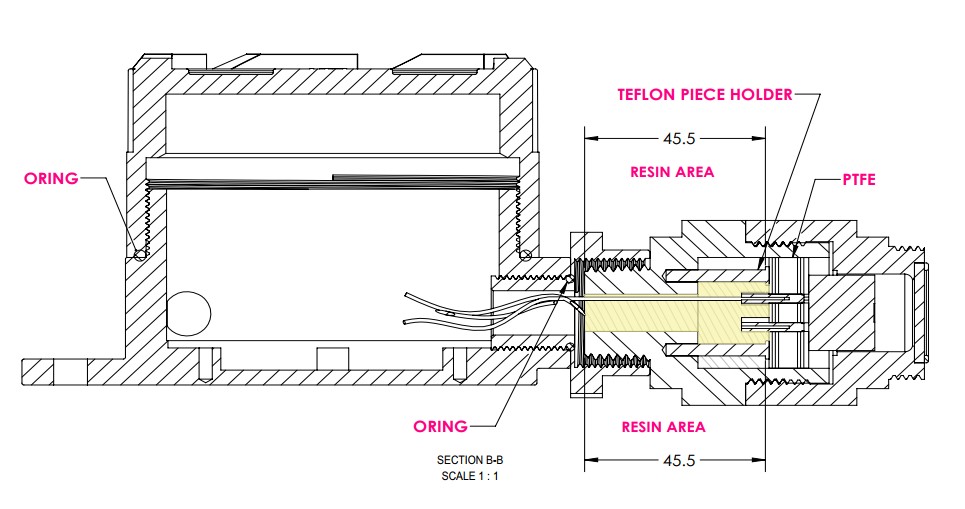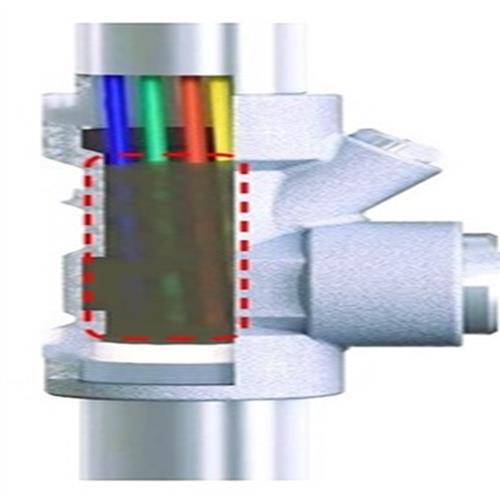Tests for Exd enclosures with cemented joints
What is a cemented joint?
Parts of an explosion-proof enclosure may be:
-
Cemented directly to the enclosure wall to form an integral assembly with the enclosure wall; or
-
Cemented in a metal frame, so that the cemented joint assembly can be replaced as a unit without damaging the cement.
An example of a cemented joint, titled Resin Area and colored yellow, is shown in the diagram below, which is for an explosion-proof gas detector.
If necessary, click on the image below to view it in a larger size.

An unmodified sample of the cemented joint assembly, representative of production, shall be used for evaluation and testing purposes.
Exception: A flameproof joint, in accordance with clause 5, which also contains cement and is tested without cement in accordance with clause 15.3 of EN/IEC 60079-1:2014, do not need to comply with the requirements of clause 6 of tthe mentioned standard and the provisions of this guide shall not apply to it.
Cemented joints are intended only to ensure the sealing of the flameproof enclosure of which they form a part.
Arrangements shall be made in the construction of the cemented joint so that the mechanical strength of the assembly does not depend solely on the adhesion of the cement.
Supplementary mechanical devices used to tighten the cemented joint shall not be removed by the opening of doors or covers which are opened during installation or maintenance.
Selection of the number of samples to perform the tests
For general explosion-proof tests, according to clause 26.4.1.2 of EN IEC 60079-0:2018, there are two alternatives for selecting the number of test samples, including the two-sample method or the four-sample method.
NOBEL CERT's policy is to use two identical samples for all tests.
However, in the case where the four-sample alternative is chosen for testing, the availability and inherent economic value of the samples should be weighed against the possible advantages of performing the different tests in parallel, but in general it is acceptable to perform the over-pressure and IP tests on different samples, in other words, out of the four samples, two samples should be allocated for the over-pressure test and the other two samples for the IP tests.
Sequence of tests for Exd enclosures with cemented joints
1- impact resistance test on two samples (referred to EN/IEC 60079-0)
2- service temperature measurement test or maximum surface temperature on one sample (referred to EN/IEC 60079-0)
Note: before performing the durability test, an optional (non-mandatory) initial overpressure test may be useful as a "pre-qualification" to save the cost and time of the durability (aging) test in case of failure with the destruction of the sample.
3- cyclic durability test or resistance to heat, humidity and cold on two samples (referred to EN/IEC 60079-0)
Note: The durability test is carried out with the aim of obtaining samples that have been artificially aged for a longer life, therefore in the order of performing explosion-proof tests for all enclosures with parts of non-metallic materials, including cemented joints, it should be carried out with priority over other tests and also on identical samples.
4- explosion (reference) pressure test on one sample according to clause 15.1 of EN/IEC 60079-1
5- Overpressure test on two samples
Note: the overpressure test must be carried out on the same two samples on which the durability or aging test has been carried out beforehand. only one overpressure test is required, after the durability test and before the IP tests.
6- IP water and dust tests on two samples (referred to EN/IEC 60079-0)
Note: It is sufficient to carry out only one IP test to verify the impermeability of the joints of of the enclosure metal body and also the proper functioning of the non-metallic sealing material used in the enclosure.
7- Non-transmission of internal ignition test on a sample based on clause 15.1 of EN/IEC 60079-1
Note: according to the requirements of clause 15.1 of EN/IEC 60079-1, the non-transmission of internal ignition test does not have any prerequisites, such as performing the general tests of IEC 60079-0 or performing the reference pressure or overpressure tests, and can be performed at any stage of the equipment test list.



